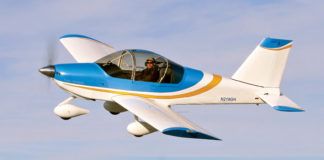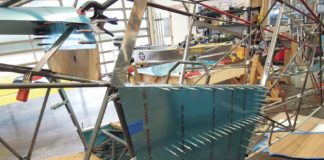
We had to fly an approach to minimums to get into Yakuta, where we met a couple of VFR guys who had been stuck there for a week due to weather. They were all smiles and said they were enjoying some of the best fishing in the world! Great decision making!
I bet a pretty fair number of you have dreamed of flying to Alaska. Perhaps some of you have already made the venture, while some of you are still dreaming. I know I dreamed about it for many years, and having just completed our third trip in four years, I thought I would pass along some lessons learned. No, this is not going to be a vacation trip report, but rather a column (or columns depending on how much I ramble on) that you might be able to refer to when it comes time for you to embark on an Alaskan adventure. However, I will tell you this: Alaska has some of the most beautiful scenery in the world, the people are super friendly, and you will be talking about it for a very long time when you get back!
Our first two trips were with fairly large groups of airplanes (15-16), and the last trip was with just two, my RV-10 and another RV-8, both of us builder-pilots. Over the course of these trips, I’ve come to the conclusion that there are three key areas that one should focus on for a trip to Alaska: the airplane, the pilot, and decision-making. Let’s start with the airplane.
First, understand that a trip to Alaska is going to be a long trip. Even from Seattle, round trip to Alaska will be approximately 30 hours or more, especially if you include some sightseeing trips while there. So all of those pesky little items that you fix every five hours (or forgot about like intermittent starting problems) are going to become a real annoyance. Most of the flying to Alaska will consume multiple three-to-four-hour legs per day, at least until you get there. And once you do get there, the scenery is so beautiful that you will most likely continue flying daily, weather permitting. You are going to be very disappointed if you are grounded waiting on parts. So, if you can’t fly your airplane for at least 25-30 hours without having to touch it, you aren’t ready for a trip to Alaska. And while Alaska is breathtakingly beautiful, it is treacherous and unforgiving at the same time. There are very few places to safely set an airplane down, and in some areas you can fly an hour or more without seeing another airport or even a safe landing spot. You need to be in an airplane that has shown itself to be reliable.
Alaska revolves around aviation probably more than any other state, so most of the FBOs are well stocked with oil and incidentals, and there is usually good, experienced help. But it is still a long ways away, and getting parts shipped can take a couple of days, especially given the time differential to the East Coast. We had one certified aircraft on our trip last year that needed an oil pressure transducer, and it took almost three days to arrive. However, I wouldn’t advocate taking all of your tools, spare tires, tubes, etc. as I have seen some pilots do. It’s just a lot of weight to haul around, and the majority of the airports are paved and well equipped. Just take enough tools to effect a small repair if needed, such as a broken wheelpant or fouled spark plug, some safety wire, and duct tape.
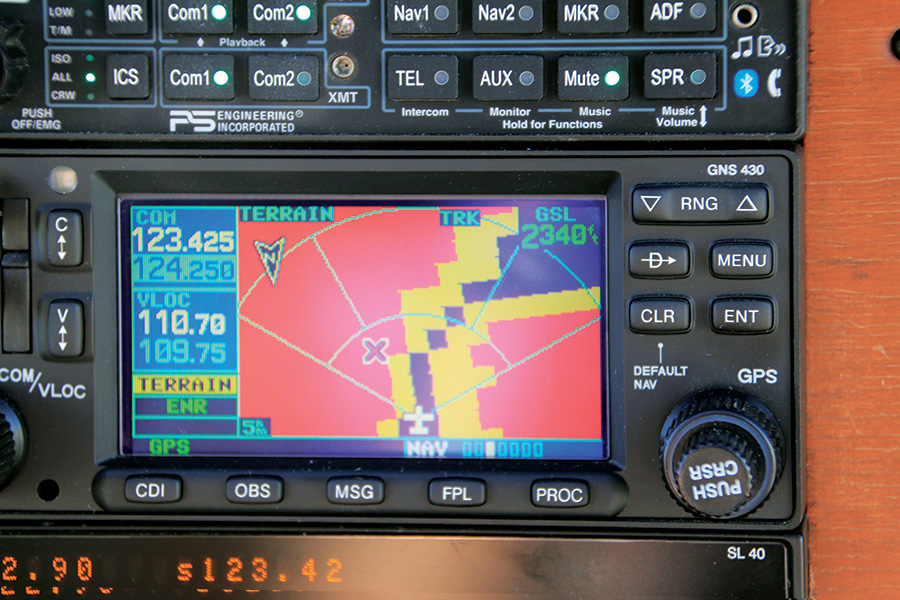
Here’s an example of why you want to disable the TAWS audio before you leave. This is going through the Whittier Pass through Turnagain Arm on the way to Anchorage.
Don’t skimp on maintenance in the last month prior to your trip. If it is going to need maintenance in the next 50 hours, do it now! And that includes alternator belts, which aren’t exactly fun to change. You’ll appreciate the alternator light staying dark while flying up the glaciers or over the water up the coast! And do check the pitot heater. You probably haven’t used it in a while, but you might on this trip. Since my engine had 700 hours on it, I took the time to change all intake hoses, intake gaskets, and cylinder drain hoses prior to the trip, as well as the usual air filter and spark plug cleaning, and installing new spark plugs on the electronic ignition system. And verify your OAT is accurate.
Another area to focus on with regards to the airplane is to make sure you understand the systems. As an example, in the lower 48, we mostly fly around with TAWS (terrain awareness and warning system) enabled. I assure you that if you don’t understand how to turn it off, or at least disable the audio, you and your passengers will not enjoy flying in Alaska. It will become very distracting. Here’s why: most of the flying will be low level or in mountainous areas following rivers. After all, the objective is to fly Alaska, not fly to Alaska. You will be getting constant warnings regarding terrain ahead. Most rivers don’t flow straight, but the TAWS can’t tell you are going to be turning. Get the picture? See the photo for clarification.
Here’s a really good example to drive home understanding your aircraft systems. I was about five minutes from the IAF (Initial Approach Fix) going into Ketchikan when my EFIS screens both presented a message: Remote AHRS failure! I have two Advanced Flight Systems 5400 touchscreens with Dual AHRS. So now I needed to figure out which one was wrong, or if they even were wrong.
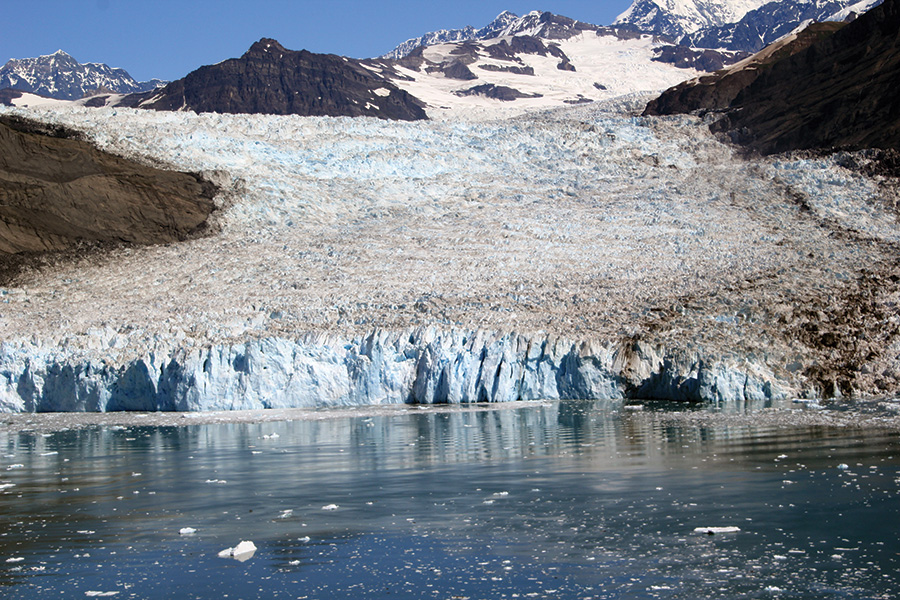
This is the Tyndall Glacier just north of Yakutat in Icy Bay. We were able to circle a few times and get some stunning pictures.
Remember the old adage regarding doing nothing except looking at your watch? Well, that’s what I did, and I also talk out loud while thinking. Heck, we were in the clouds, and Carol had nothing to watch except me. As I was talking out loud, I realized I also no longer had any engine information displayed. It was then I realized that the common failure was not the AHRSs or EFISs, but the network hub that ties it all together. I quickly deduced that resetting the hub would probably rectify the situation, but I hadn’t put the hub on a resettable and accessible circuit breaker. I had checked before I left that all battery-powered units did in fact work properly when aircraft power was removed. This included both of the EFIS’s, the Dynon D-10A, and Garmin 496. I also had the iPad up and running, as well as the iPhone with the Gyro app.
With three minutes to the IAF, I cycled aircraft power and everything came back up with a minute to spare. Unfortunately, ATC compounded the problem by keeping us way too high for the autopilot to capture the vertical nav on the glideslope, so the approach was hand flown. Everything worked out fine and it was a non-event.
That is probably a good segue to the next area of focus, which is pilot proficiency. All of the skills we developed while learning to fly will be used, and sometimes to the max. At times you will be operating your airplane at the edge of its envelope, or in conditions much different than normal.
As an example of the wide spectrum of conditions you may experience, while on final approach into the Cheyenne Airport in Wyoming, I checked the density altitude. It was 9400 feet! The ILS into Cordova, AK less than a week later was at sea level with mountains on one side, and we were solid IMC. As an extra challenge, ATC kept us at 6900 feet until 10 miles from the FAF, which was at 2800 feet. Normal descent profile clearly wasn’t going to work here. Time to get the power back and slow way down if we had any hope of making it work. Oh, that nice tailwind that we were so happy for on the way up here wasn’t exactly our friend right now. It all worked out, and I was very glad for all of the practice instrument approaches I did in the weeks leading up to the trip. We ended up with five approaches on this most recent trip, three of them to minimums, and about eight hours of IMC. This was a lot more IMC time than in past trips, so I don’t really know what is normal yet.
The other area of proficiency that is probably the weakest for most of us is VFR pilotage. Remember, pilotage is getting somewhere by looking out the window, not looking in the window at all of the toys. I find the moving map displays, and an iPad with ForeFlight or equivalent, that have sectional display capability to be of the greatest benefit in Alaska, especially when navigating through the mountain passes or the inland waterways. At low levels, things look a whole lot different, and it takes patience to not take that early turn up the canyon with the dead end, instead of the next canyon that has the pass.
The same goes for rivers, especially where rivers converge. It is very easy to take a wrong turn or not turn when you are supposed to turn. Go out and practice this for a couple of hours sometime, navigating only by looking out the window and do it in unfamiliar terrain. Do take a safety pilot. We talk out loud a lot in the cockpit while doing this, and verify that we both agree on what we are looking at.
At the same time, do take advantage of all the bells and whistles that you might have in the cockpit. I loved the ADSB in Alaska. It seemed to work really well, and in fact, I could see N-numbers of the seaplanes, and in some cases I radioed to them by N-number to ask for weather updates. What a wonderful tool.
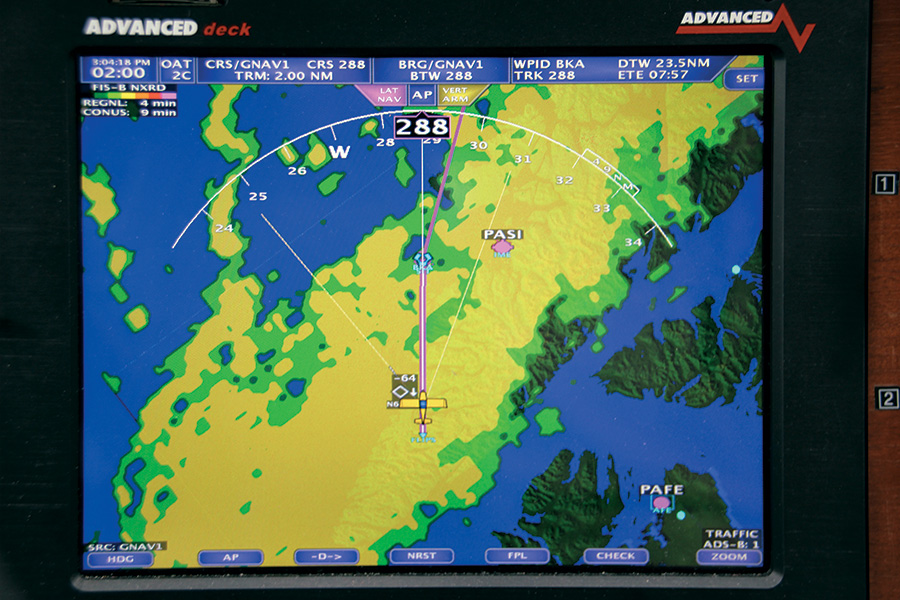
The ADSB was really accurate and useful up the coast of Alaska. We could see continuous seaplane traffic below us at 500 feet ASL. The ride in the precip was very smooth, but we were constantly watching the OAT.
Did I tell you Alaska weather doesn’t seem to be very constant, and there are very large gaps in weather reporting? Talk to the locals, even non-pilots, whenever you can. And call the local FSS for briefings. Or stop in personally at Ketchikan, as it is right on the field.
There are also some really cool aviation apps that can give you a direct view from all of the weather cams strategically placed throughout Alaska. They give true meaning to “a picture is worth a thousand words”!
Speaking of local differences, do take and read the FAA’s Alaska Supplement. In many places there are special VFR procedures, especially in Anchorage, that you are expected to know and comply with.
Well, it looks like I’m just about out of room for this issue, so I’m going to continue next month with decision-making. However, I’ll close with this one humorous lesson learned on this trip. It can get boring in the clouds, and while on one such leg Carol said, “Why don’t you clean your screens?” So, without thinking, I started to wipe them with a lens cleaning cloth. I guess I don’t need to tell you that cleaning the touch screens in flight is not a best practice!
See you next month…

![]()
Vic is a Commercial Pilot and CFII with ASMEL/ASES ratings, an A&P, DAR, and EAA Technical Advisor and Flight Counselor. Passionately involved in aviation for over 36 years, he has built nine award-winning aircraft and has logged over 7400 hours in over 65 different kinds of aircraft. Vic had a career in technology as a senior-level executive and volunteers as a Young Eagle pilot and Angel Flight pilot. He also has his own sport aviation business called Base Leg Aviation.











